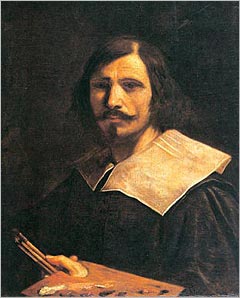The Artist - Guercino (Giovanni Francesco Barbieri) |
In his lifetime, Giovanni Francesco Barbieri was known as "Guercino," or "squinter." Born in Cento, in the Northern Italian province of Emilia, Guercino received his early training in Bologna at the Carracci Academy. After studying the work of his contemporaries, Guercino eventually forged his own style - a fusion of Bolognese naturalism, Roman classicism, and Venetian colorism. Between 1621 and 1623 Guercino worked in Rome for the newly elected Pope Gregory XV, a former Bolognese cardinal. There, he executed numerous commissions, including the fresco cycle for the Sala dell'Aurora at the Ludovisi, a private retreat belonging to the papal family.
After Pope Gregory XV died in 1623, Guercino returned to his native Emilia. In 1642, he moved to Bologna, where he became the undisputed leader of the Bolognese school, and enjoyed an international reputation until his death. Guercino executed the Institute’s Erminia and the Shepherds in 1648, one of two versions he produced for prominent patrons, and an excellent example of Guercino’s mature style. |
 |
1591
Born on February 2 in Cento, Italy, and baptized Giovanni Francesco Barbieri on February 8. Later nicknamed Guercino (meaning "squinter") because of a noticeable eye abnormality.
1600
At nine years of age, learns rudiments of painting from the architectural perspective painter Paolo Zagnoni.
1613
Receives his first independent commission for an altarpiece in Cento.
1616
Opens a drawing academy in Cento.
1617
In Bologna, works with Ludovico and Agostino Carracci.
1618
Travels to Venice.
1621
Departs for Rome, where he remains for two years. Working for Pope Gregory XV, receives commission for The Burial of Saint Petronilla in St. Peter's Basilica.
1626
King Charles I of England commissions two paintings and requests that Guercino move to London to serve as court painter. Guercino completes the paintings but declines the offer.
1629
Begins his account book, the Libro dei conti, as a record of his commissions.
1642
Following the death of Guido Reni, moves to Bologna and succeeds Reni as the leading painter there.
1644
Purchases a house in Bologna.
1648
Begins first version of Erminia and the Shepherds in the summer; begins the Minneapolis version by autumn. Works on both paintings simultaneously, completing them by January 1649.
1655
Queen Christina of Sweden visits Guercino in his studio.
1660
Commissioned by one of his principal patrons, the Sicilian collector Don Antonio Ruffo, to paint a companion piece (now lost) for Rembrandt's Aristotle Contemplating the Bust of Homer (now in The Metropolitan Museum of Art, New York)
1666
Dies on December 22. Buried in the church of San Salvatore, Bologna.
|
Guercino, Self Portrait c. 1624-26
Oil on Canvas
Collection of Richard Feigen |
